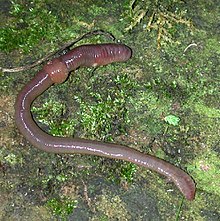Wikijunior:Bugs/Earthworm

What do they look like?[edit | edit source]
Earthworms are smooth-skinned worms, with a body made of many small segments. If you look at the body you can see lines that mark the segments. Each segment has stiff little hairs that help the worm move, sometimes the hairs are hard to see.
Where does it live?[edit | edit source]
The habitat of an earthworm is underground, within the soil. This can take on very different qualities depending on the worm's location; living underground in a tropical rainforest, for example, leads to much more food but also more risks from predators. An earthworm who lives in poorer soil in temperate regions, by contrast, may have to eat more but has less of a chance of being eaten by predators, like birds, mice, and insects. These worms live underground their entire lives except for during heavy rainfall. Worms cannot survive very wet soil and must rise to the surface to breath when there is excessive rain. Only a few species of worm actually go deeper into the soil in very wet conditions.
What does it eat?[edit | edit source]
Earthworms eat soil. Their nutrition comes from things in soil, such as decaying roots and leaves. Animal manures are an important food source for earthworms. They eat living organisms such as nematodes, protozoans, rotifers, bacteria, fungi in soil.
How does it defend itself?[edit | edit source]
What earthworms can do is burrow. They have small bristles, known as setae, which are both sensing devices that can identify any soil vibrations and digging aids. The setae stick to dirt and the worm then contracts its body to force itself through soil. The worm also secretes a mucus that helps it slide through dirt more quickly. In fact, to escape the cold of winter or an eager predator, the earthworm can burrow dozens of feet below the surface. Earthworms also are aware of when it's safest to come out of hiding: at night. The only other time you're likely to see earthworms is after a rain. This is not necessarily because of what you may have heard, that the worm is trying to avoid drowning. In fact, an earthworm gets its oxygen through its skin, and can survive several weeks if it is submerged. The more likely reason is that the rain keeps the worm from becoming too dry, as it normally would in sunshine, and allows it a chance to find a mate. The earthworm might also be coming to the surface to move more quickly to colonize new ground or to forage for food during weather when predators are less likely to be out.
What stages of metamorphosis does it go through?[edit | edit source]
In earthworms, development of adult is direct. Bugs that have larval stage during development show metamorphosis. Metamorphosis includes larva and pupa stage during development of egg into adult. Earthworms do not show larval and pupa stage during their development
What special behavior does it exhibit?[edit | edit source]
During the day earthworms mostly stay in their burrows underground. At night they come up near or on to the surface to feed. If the air it is too cold or too dry, they stay down in the soil. Some species also come on to the surface during the day if it is raining.
How does this bug affect people?[edit | edit source]
Earthworms are good for plants and good for people because we eat plants. Earthworms are good for all plants and animals because they keep the soil healthy. They harmless to us on our skin but do not like to crawl on us because our skin is too warm for them.
References[edit | edit source]
Earthworms - BioKIDS - Kids' Inquiry of Diverse Species University of Michigan http://www.biokids.umich.edu/critters/Oligochaeta/